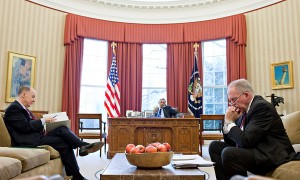Jack Goldsmith to John Brennan: Not Good Enough
When he gave a speech to make misleading claims about the drone program, John Brennan claimed his speech fulfilled Jack Goldsmith’s demand for more transparency.
Jack Goldsmith, a former assistant attorney general in the administration of George W. Bush and now a professor at Harvard Law School, captured the situation well. He wrote:
“The government needs a way to credibly convey to the public that its decisions about who is being targeted, especially when the target is a U.S. citizen, are sound. First, the government can and should tell us more about the process by which it reaches its high-value targeting decisions. The more the government tells us about the eyeballs on the issue and the robustness of the process, the more credible will be its claims about the accuracy of its factual determinations and the soundness of its legal ones. All of this information can be disclosed in some form without endangering critical intelligence.”
Well, President Obama agrees. And that is why I am here today.
In response to Brennan’s speech, Goldsmith wrote a mostly-approving post, deeming Brennan’s speech to have fulfilled his call for more transparency.
Brennan’s speech, taken together with earlier speeches on related topics by top government officials, strikes me as meeting if not exceeding the administration’s “good government” duty to explain to the American people the legality and justification for and operation of its targeted killing program.
But in the wake of the NYT and Daily Beast pieces, Goldsmith has intensified a criticism he made in the earlier post: in the face of all this sanctioned leaking, Goldsmith argues, the Administration should not be able to sustain their Glomar invocation in ACLU’s FOIA suits.
The story and the excerpt are based on interviews with dozens of current and former Obama advisors. They contain fine-grained details about the CIA’s involvement in drone strikes, internal USG processes and deliberations concerning the CIA strikes, internal USG criticisms and defenses of the CIA strikes, and the consequences of the CIA strikes. At the same time that many officials are talking to Becker and Shane and Klaidman about the CIA drone strikes in the hope that the journalists will report what they say, the USG maintains that the CIA can neither confirm nor deny that it has responsive records about its involvement in drone strikes. The USG’s position is that such a Glomar response is appropriate because there has been no official acknowledgment of CIA involvement in drone strikes, and “whether or not the CIA was involved in drone strike operations . . . is a classified fact.”
He argues that, given all the leaks, the DC Circuit should rule against the government’s Glomar invocation.
The basic question before the CADC is whether this rationale applies to the CIA program. There are actually at least two questions here: (1) Has the USG officially acknowledged CIA drone strikes?; and (2) Even if the USG has not officially acknowledged CIA involvement in the strikes, should it be required to do so in light of its manipulation of the secrecy system through extensive opportunistic leaks? On both issues I find myself increasingly in the ACLU camp.
[snip]
I increasingly believe there must be some limit. Protecting the credibility of foreign governments in places where dangerous terrorists lurk is a relative value, not an absolute one; and at some point a government that consistently and extensively leaks information about covert action should lose the protections of Glomar, even if the purposeful leaks do not amount to official acknowledgment.
While I of course agree that the government shouldn’t be able to claim all the stuff they’re willingly revealing is still classified, I’d like to push something Goldsmith says one step further. He entertains the counter-argument the government might make–that leaking wildly while preserving Glomar provides a kind of accountability–but predicts a narrowing of Glomar won’t hurt this dynamic.
One argument in favor of the government’s practice of leaking information about CIA drone strikes while at the same time insisting on (and receiving) full Glomar protection in FOIA cases is that the system allows the USG to tell the American public about what it is up to while at the same time preserving diplomatic confidences. In other words, leaks about the CIA drone program can be seen as a democratic-accountability-promoting compromise. Setting aside that government leaks inevitably serve the interests of the leaker, this argument entails that if the Glomar rationale is narrowed as a result of leaks, the consequence in the next round of covert programs will be less government disclosure through leaks and thus less government accountability. This is an important argument that underscores the complexities in this area. I am skeptical, however, because I think he government will continue to leak for multiple self-serving reasons, even if Glomar is narrowed in the covert action context.
Goldsmith admits that these leaks are self-serving. But they are also something else.
Regarding the central issue of the decision-making process Goldsmith emphasized, false.

